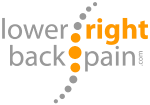If you get an injury such as a sprained ankle or pulled muscle, quick first aid treatment can help heal you faster. One of the most popular acronyms to remember if you get a sports injury is the "RICE" method, which stands for Rest, Ice, Compression and Elevation. When applied to lower right back pain the Compression and Elevation have little value (as opposed to an injury to an extremity) given the structural make-up of the back and proximity to the heart. We can substitute Chiropractor care for compression and we get the “RIC” for low back pain. Using these first aid measures will relieve pain, limit tissue swelling and protect the are from further injury.
Rest
Resting the back is important and often mandatory to reduce pain. Resting [or dramatically reduced activity (or active rest)] protects the injured muscles and other tissues from further injury. After 2 days slowly increase activity level/movement.
- Take non-prescription anti-inflammatory pain relievers
- Movement and exercise are needed to keep the back health. Without exercise the muscles and spinal disc will slowly degenerate and become less able to support the body. It may be counter-intuitive but you need to be up and moving if possible. Activity helps move nutrients and fluids within the muscles and discs to keep them fit.
- Slowly return to your usual activities after pain has subsided and mobility is close to normal. This could be after a week to two or more if severly injured. Avoid heavy lifting or twisting for at least the first month after the pain began. Try to start a moderate (customized) exercise program after two weeks. The program should include strengthening of the core muscles and spine flexibility.
Ice
Ice is such a simple yet effective way to help heal injuries. Ice helps reduce swelling, inflammation, pain, muscle spasms and tissue damage. More technically it reduces blood flow and metabolic requirements of the muscle.  Along with the reduction in blood flow is a reduction in the inflammation response chemicals, which in overabundance lead to excess pain and scar tissue. The sooner you use ice after an injury the better.
Along with the reduction in blood flow is a reduction in the inflammation response chemicals, which in overabundance lead to excess pain and scar tissue. The sooner you use ice after an injury the better.
Fifteen minutes should be the upper limit for a single application, but this can be repeated hourly. Be careful as putting ice directly on the site of an injury is going can produce blistering and ice burn–, so it should be wrapped in polythene, crushed and further wrapped in a damp towel or t-shirt.
- Get ice on your injured back as soon as possible. Ice should be applied for 15 to 20 minutes (a few times a day). Ice helps reduce pain, swelling and inflammation and will speed the healing process. Icing slows blood flow into the tissues and the blood vessels and reduces overall inflammation. You should also use ice during rehabilitation.
Heat
Heat therapy can be used for chronic pains and after 2-3 days for acute injuries (once the swelling has gone down). Heat will help increase the range of motion or when stretching the injured muscle and doing light exercises. Heat increasing blood flow bringing red blood cells, nutrients, oxygen and protein to the area. For acute injuries heat should be applied 2-3 days after injury and helps reducing inflammation (which might seem counterintuitive). However, If applied to an injury too earlier, heat could lead to further inflammation. Heat should typically be used before (not after) exercise.
Chiropractic Treatment
Chiropractors aim to relieve pain from muscles, connective tissues (joints), and bones. Chiropractors perform spinal manipulation and other alternative treatments using their hands, body weight and other modalities. The goal (and belief) is that proper alignment of the spine and other joints, will enable the body to heal itself without surgery. Manipulation is used to restore mobility to joints where muscles and ligaments are restricting. This restriction can be caused by a stressful event (i.e. car accident or fall), or from a repetitive stress (i.e. over-typing or sitting with bad posture). Chiropractors often combine more traditional physical therapy style treatments along with more alternative methods. Chiropractors are known for implementing non-invasive alternative methods for the treatment of lower right back pain including: mobilization, exercise therapy, massage, electrical muscle stimulation, lifestyle and ergonomic advice, nutritional/diet recommendation, and more). Multiple studies have shown that chiropractic therapies have been successful in reducing back pain (beyond placebo and over-the-counter medication standards).
Osteopathic Manipulative Medicine
Osteopathic Manipulative Medicine (or OMM) is an alternative to chiropractic medicine (but has similarities). The practice is based upon the principle that the human body can heal itself. The Osteopath is trained to discover the treatment plan that the body’s internal forces have already designed, in that moment, specifically for that patient. The treatment is suppose to go beyond spinal alignment (performed by a chiropractor), to dealing with the abnormal body physiology using various techniques. Osteopathic physicians must go through the same amount of schooling as medical doctors and have the right to perform surgery and prescribe medicine.
The RICE method Rest, Ice, Compression and Elevation (combined with anti-inflammatory drugs if desired) is the best immediate response to most muscle and joint injuries. Full rehabilitation requires time, strengthening (and stretching) exercises and possible lifestyle changes.
